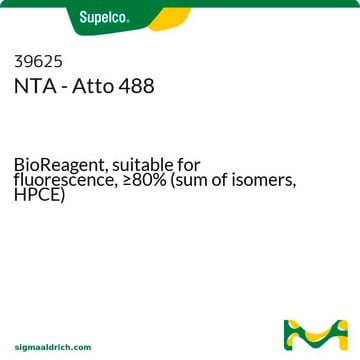74417
Atto 488 amine
BioReagent, ≥90% (HPLC), suitable for fluorescence
Sign Into View Organizational & Contract Pricing
All Photos(1)
About This Item
UNSPSC Code:
12352116
NACRES:
NA.32
Recommended Products
product line
BioReagent
Quality Level
Assay
≥90% (HPLC)
form
solid
mol wt
Mw 858 g/mol
manufacturer/tradename
ATTO-TEC GmbH
λ
in methanol: water (1:1) (with 0.1% perchloric acid)
UV absorption
λ: 502-508 nm Amax
suitability
suitable for fluorescence
storage temp.
−20°C
General description
Atto 488 is a fluorescent label with excellent water solubility. Characteristic features of the label are strong absorption, high fluorescence quantum yield, high photostability, and very little triplet formation. Thus Atto 488 is highly suitable for single-molecule detection applications and high-resolution microscopy such as PALM, dSTORM, STED etc. Additionally the dye highly qualifies to be applied in flow cytometry (FACS), fluorescence in-situ hybridization (FISH) and many more. The fluorescence is excited most efficiently in the range 480 - 515 nm. For instance the 488 nm line of the Argon-Ion laser is very suitable for excitation.
find more information here
find more information here
Legal Information
This product is for Research use only. In case of intended commercialization, please contact the IP-holder (ATTO-TEC GmbH, Germany) for licensing.
Storage Class Code
11 - Combustible Solids
WGK
WGK 3
Flash Point(F)
Not applicable
Flash Point(C)
Not applicable
Personal Protective Equipment
dust mask type N95 (US), Eyeshields, Gloves
Certificates of Analysis (COA)
Search for Certificates of Analysis (COA) by entering the products Lot/Batch Number. Lot and Batch Numbers can be found on a product’s label following the words ‘Lot’ or ‘Batch’.
Already Own This Product?
Find documentation for the products that you have recently purchased in the Document Library.
Customers Also Viewed
Analysis of fluorescent nanostructures in biological systems by means of spectral position determination microscopy (SPDM).
Muller, P., et al. et al.
Current Microscopy Contributions to Advances in Science and Technology, 1, 3-12 (2012)
Monitoring single membrane protein dynamics in a liposome manipulated in solution by the ABELtrap.
Rendler, T., et al.
arXiv, 1102-1102 (2011)
Mohd A Mohd Ridzuan et al.
PloS one, 7(3), e33845-e33845 (2012-04-06)
An actomyosin motor complex assembled below the parasite's plasma membrane drives erythrocyte invasion by Plasmodium falciparum merozoites. The complex is comprised of several proteins including myosin (MyoA), myosin tail domain interacting protein (MTIP) and glideosome associated proteins (GAP) 45 and
Tilak Jain et al.
Journal of structural biology, 179(1), 68-75 (2012-05-10)
Over the last three decades, Cryo-TEM has developed into a powerful technique for high-resolution imaging of biological macromolecules in their native vitrified state. However, the method for vitrifying specimens onto EM grids is essentially unchanged - application of ∼3 μL
Jonas K Hannestad et al.
ACS nano, 7(1), 308-315 (2012-12-12)
We use single-molecule fluorescence microscopy to monitor individual hybridization reactions between membrane-anchored DNA strands, occurring in nanofluidic lipid monolayer films deposited on Teflon AF substrates. The DNA molecules are labeled with different fluorescent dyes, which make it possible to simultaneously
Our team of scientists has experience in all areas of research including Life Science, Material Science, Chemical Synthesis, Chromatography, Analytical and many others.
Contact Technical Service







